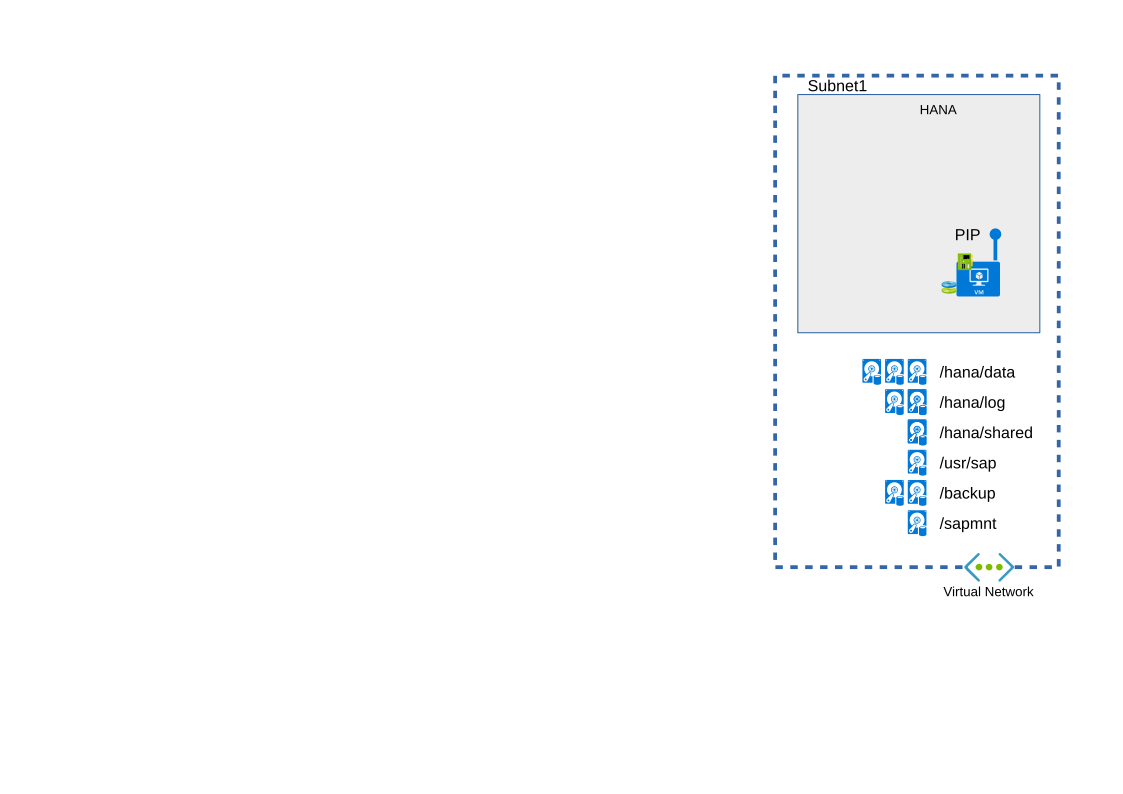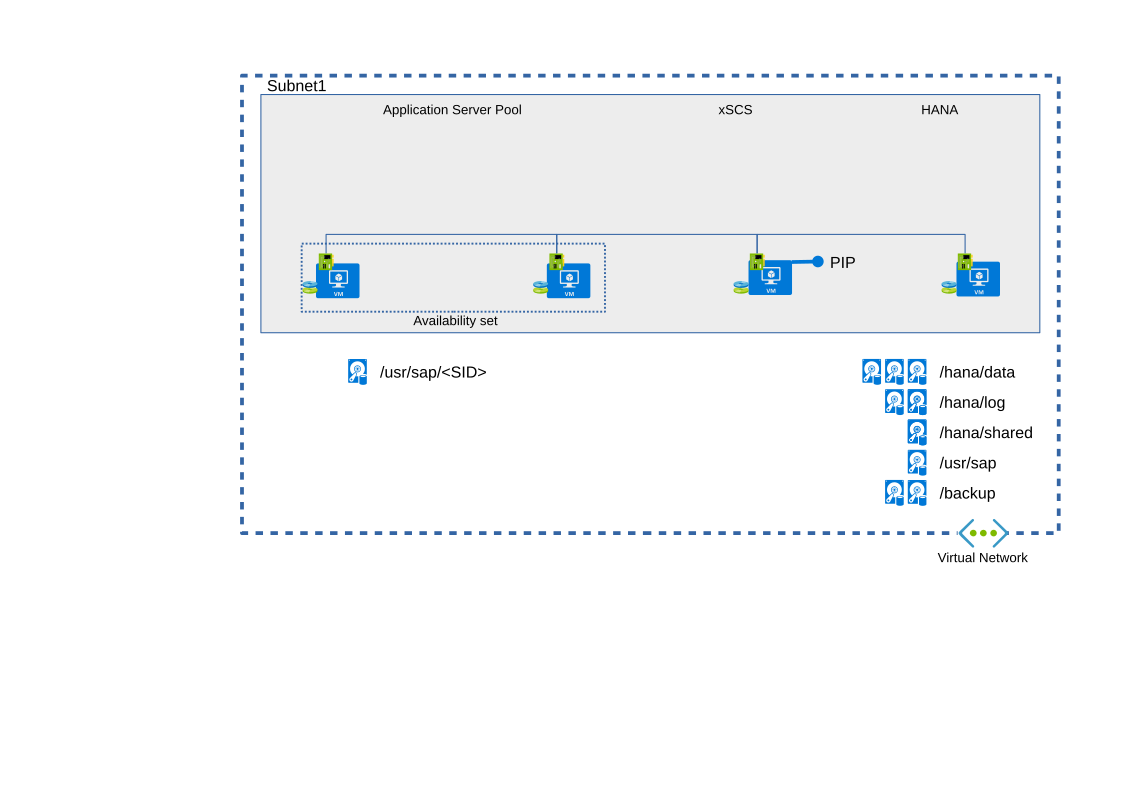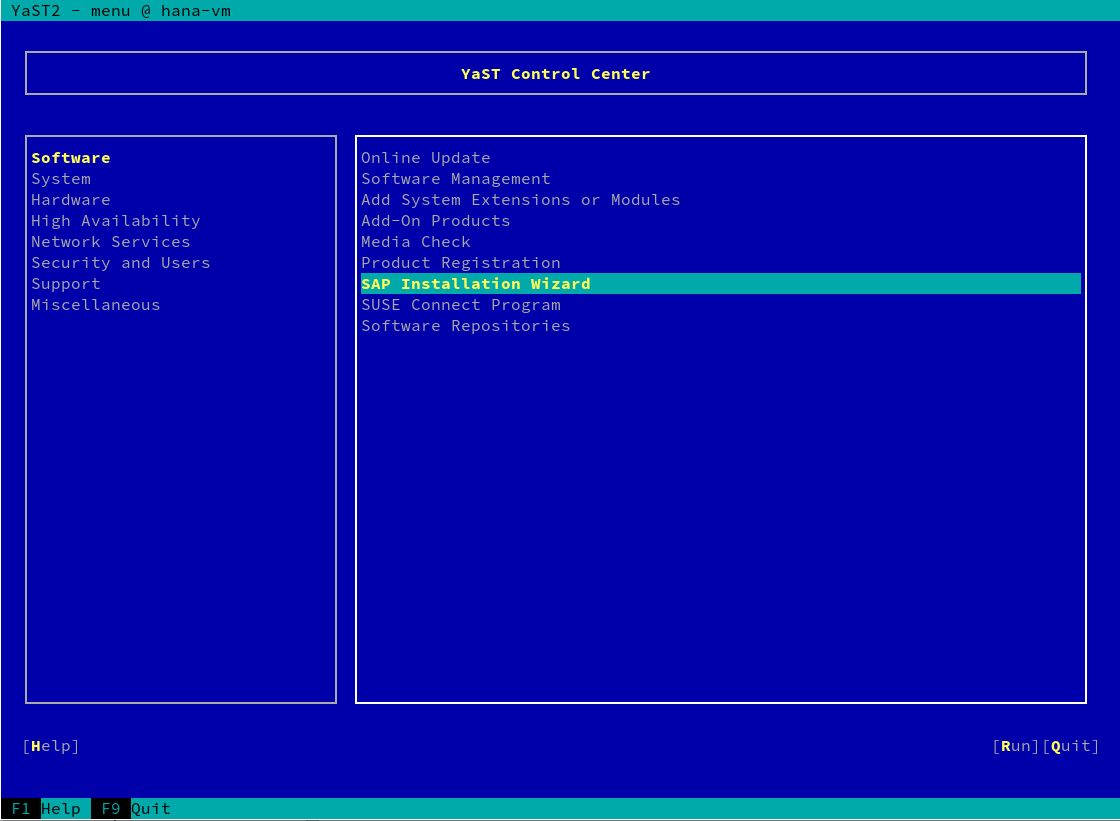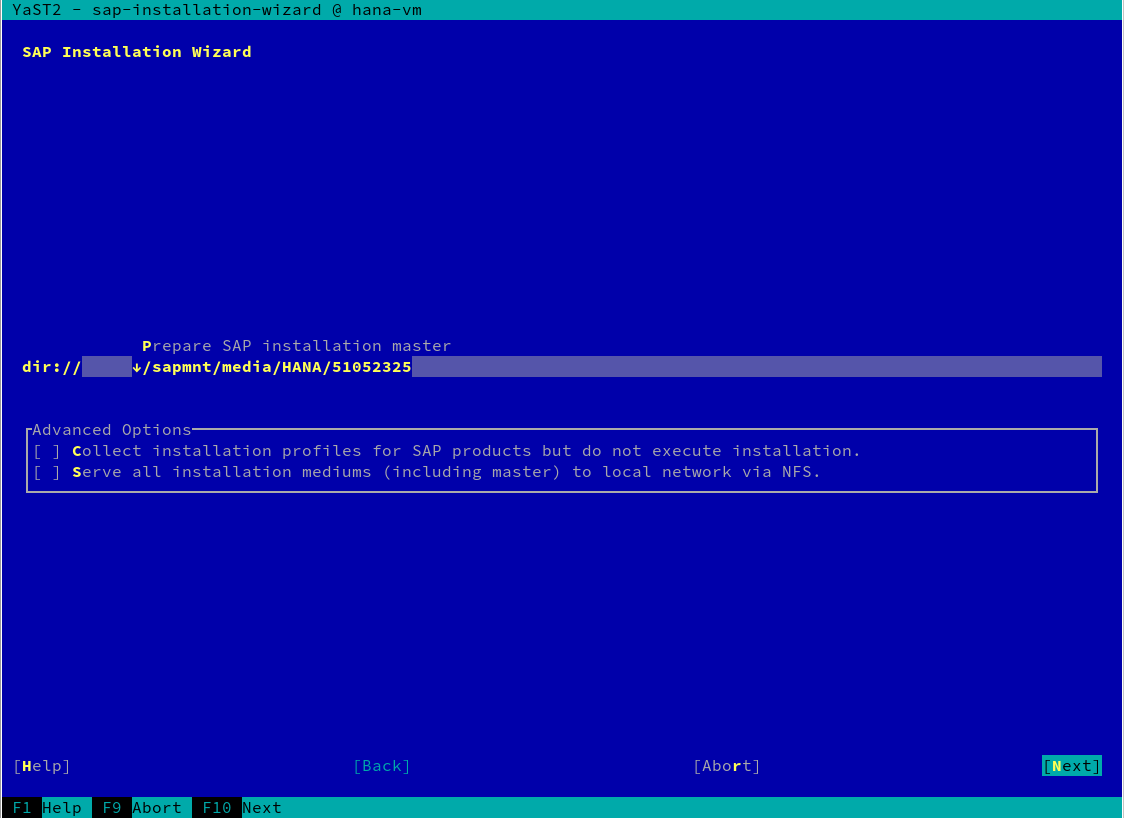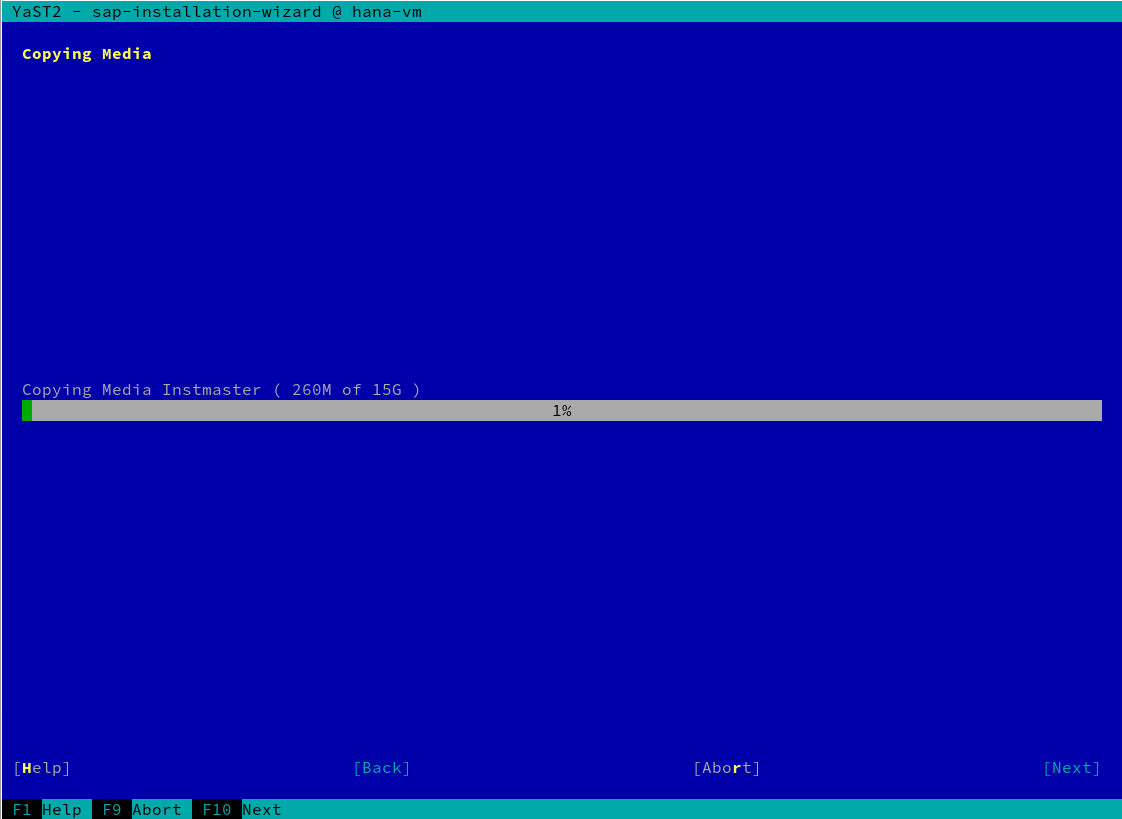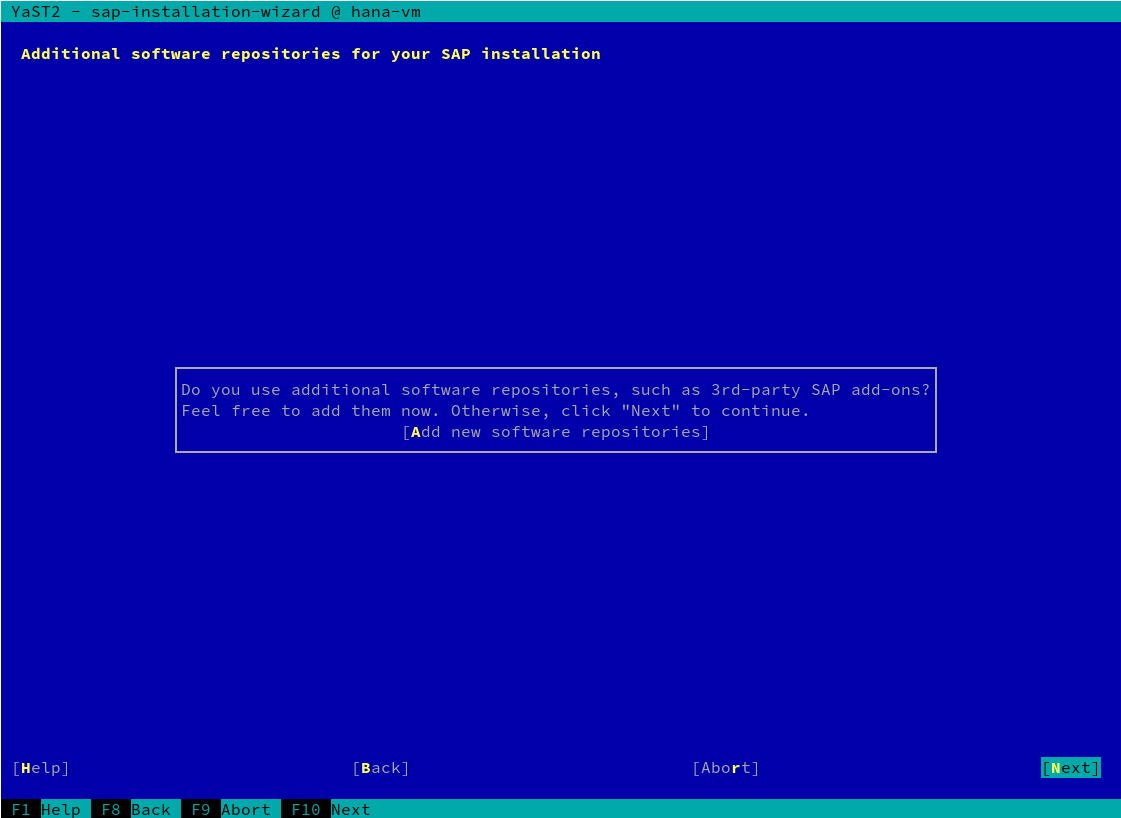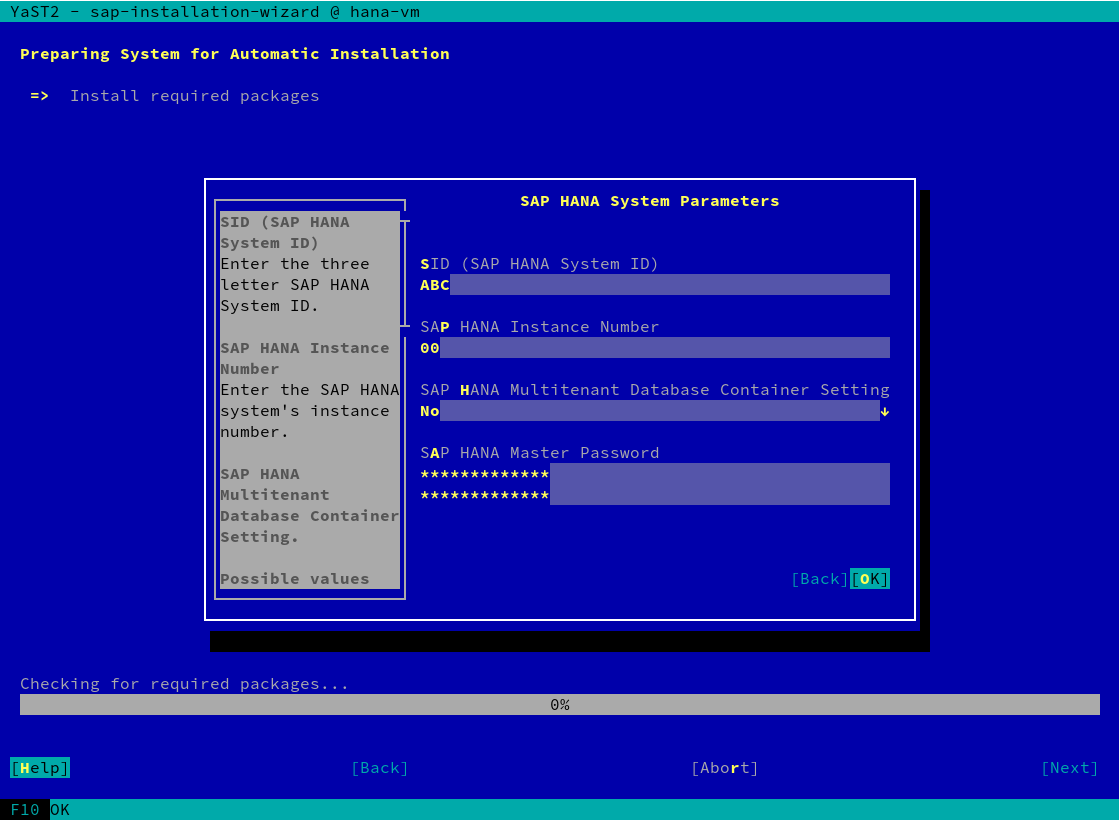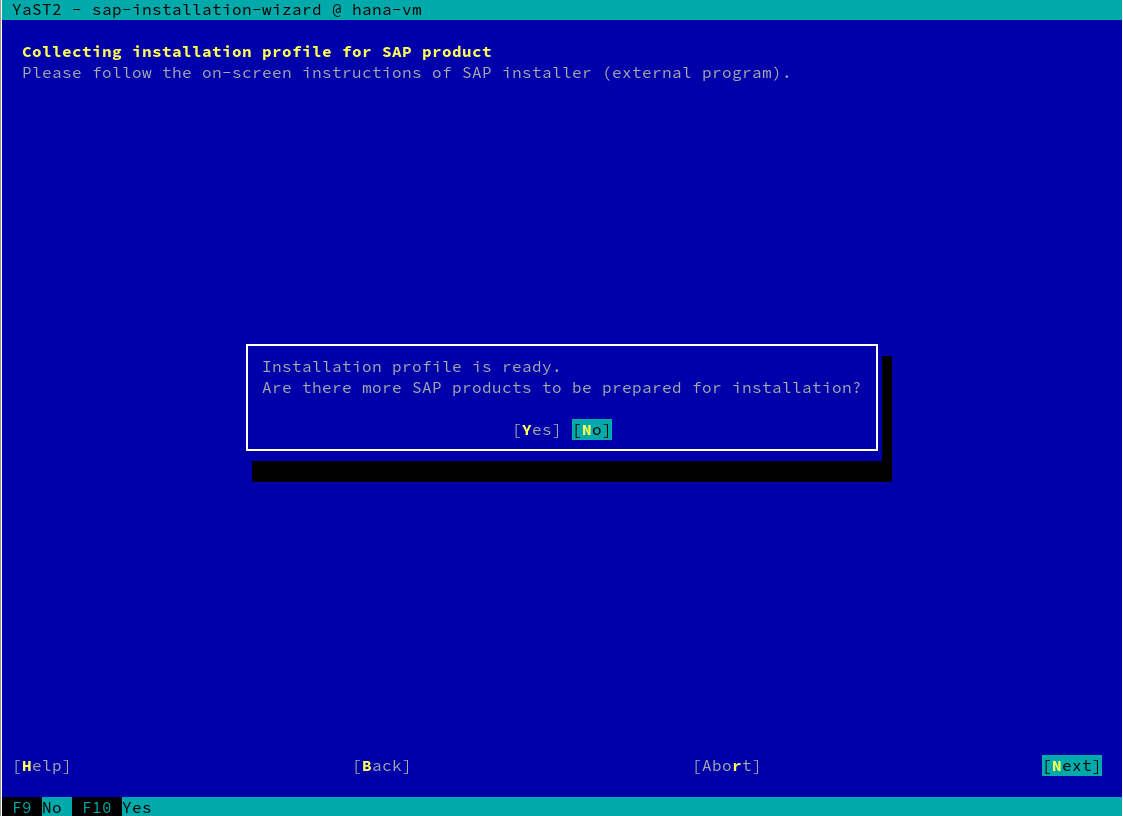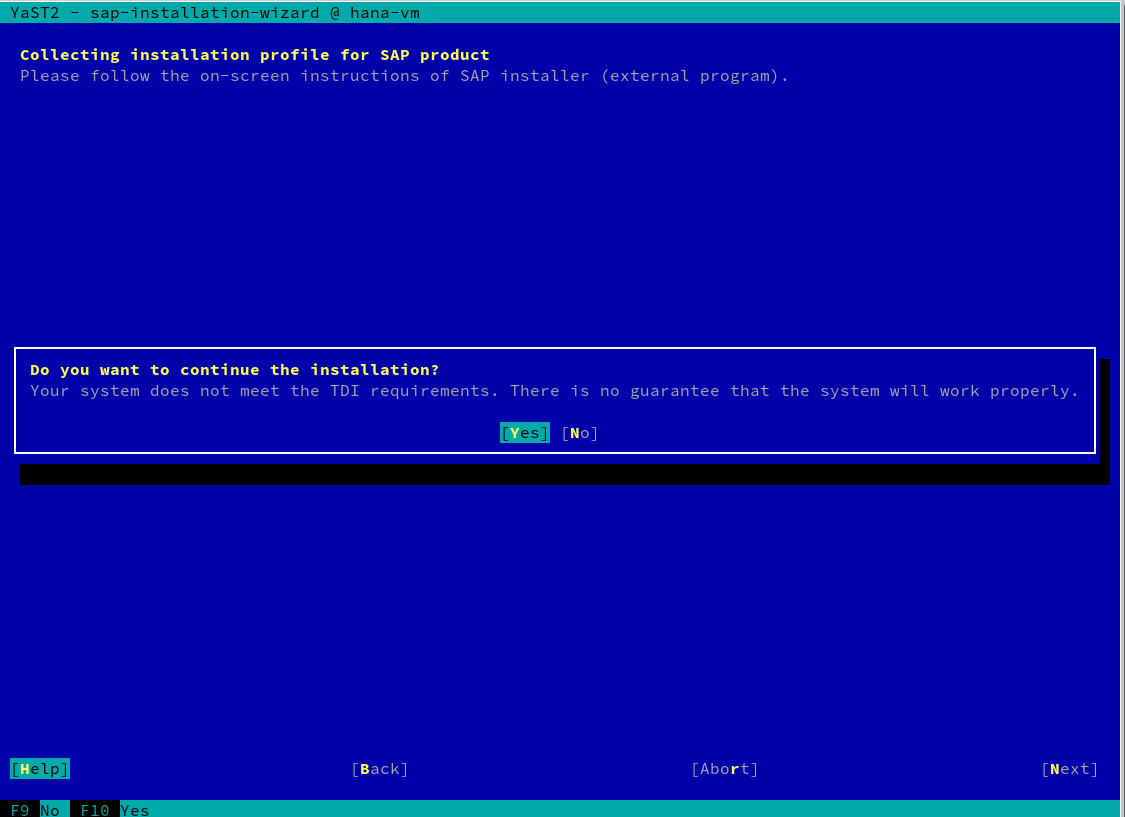SUSE and Microsoft Solution Templates for SAP applications
Simplified Deployment on Microsoft Azure
SAP
This document describes several predefined solution templates for SAP applications from SUSE and Microsoft for simplified deployment on Microsoft Azure.
Disclaimer: Documents published as part of the SUSE Best Practices series have been contributed voluntarily by SUSE employees and third parties. They are meant to serve as examples of how particular actions can be performed. They have been compiled with utmost attention to detail. However, this does not guarantee complete accuracy. SUSE cannot verify that actions described in these documents do what is claimed or whether actions described have unintended consequences. SUSE LLC, its affiliates, the authors, and the translators may not be held liable for possible errors or the consequences thereof.
1 Overview #
For every template there are four possible sizes available with the following naming convention:
Demo
Small
Medium
Large
The Demo and Small sizes are targeted at non-production SAP HANA workloads. The Medium and Large sizes can be used for production systems, as they are built on M-SERIES/VM which are certified.
One of the presumptions of this document is that you are familiar with SAP Netweaver and SAP HANA.
Microsoft provides a good overview page about SAP deployments in Azure at https://docs.microsoft.com/en-us/azure/virtual-machines/workloads/sap/get-started
For the High Availability (HA) scenario you should have in addition good knowledge of
High availability for SAP NetWeaver (ASCS/SCS/ERS)
the SUSE High Availability Extension
the best practice documents at https://www.suse.com/products/sles-for-sap/resource-library/sap-best-practices
For production systems you need to take care of the monitoring requirements of SAP:
https://launchpad.support.sap.com/#/notes/2191498/E [SAP Note 2191498]. This note discusses SAP “enhanced monitoring” with Linux Virtual Machines (VMs) on Azure.
https://launchpad.support.sap.com/#/notes/1102124/E [SAP Note 1102124]. This note discusses information about SAPOSCOL on Linux.
https://launchpad.support.sap.com/#/notes/2178632/E [SAP Note 2178632]. This note discusses key monitoring metrics for SAP on Microsoft Azure.
You need to provide the SAP software and license by yourself. You can download SAP software from the SAP Service Marketplace (https://service.sap.com)
To prepare the Azure VM for the SAP Netweaver and HANA installation, follow the steps outlined in the section below.
1.1 Operating System Updates #
Check for SUSE Linux Enterprise Server operating system updates and fixes before installing additional software. By installing a patch, you might be able to avoid calling the support desk.
Here is an example of how to check for available patches for
SUSE Linux Enterprise Server by using the zypper
command:
sudo zypper list-patches
Depending on the kind of issue, patches are classified by category and severity.
Commonly used values for category are: security, recommended, optional, feature, or yast.
Commonly used values for severity are: critical, important, moderate, low, or unspecified.
The zypper command searches only for the
updates that your installed packages need. As an example, you could
use the command:
sudo zypper patch --category=security,recommended --severity=critical,important
You can add the parameter --dry-run to test the update without actually updating the system.
2 SAP HANA 2-tier (DB-tier) Template #
The template provides and deploys a VM that is customized for use with SAP HANA, using the latest pay-as-you-go (PAYG) version of the SUSE Linux Enterprise Server for SAP applications (SLES4SAP).
It deploys one server on Premium Storage (Premium_LRS) and uses Managed Disks.
2.1 OS Configuration for SAP HANA #
SAP HANA requires specific Linux kernel settings, which are not part of the standard Azure images and must be set manually.
sudo saptune solution apply HANA
2.2 Disk Overview #
The template uses the following disks and mount points for the HANA machine:
Demo
| Mount Point | Disk | Size |
|---|---|---|
|
/hana/data |
0,1 |
128 GB |
|
/hana/log |
2,3 |
128 GB |
|
/hana/shared |
4 |
128 GB |
|
/usr/sap |
5 |
128 GB |
|
/hana/backup |
6 |
128 GB |
|
/sapmnt |
7 |
128 GB |
Small
| Mount Point | Disk | Size |
|---|---|---|
|
/hana/data |
0,1,2 |
512 GB |
|
/hana/log |
same disks as data | |
|
/hana/shared |
3 |
512 GB |
|
/usr/sap |
4 |
64 GB |
|
/hana/backup |
5 |
1024 GB |
|
/sapmnt |
6 |
64 GB |
Medium
| Mount Point | Disk | Size |
|---|---|---|
|
/hana/data |
0,1,2,3 |
512 GB |
|
/hana/log |
4,5 |
512 GB |
|
/hana/shared |
6 |
1024 GB |
|
/usr/sap |
7 |
64 GB |
|
/hana/backup |
8,9 |
1024 GB |
|
/sapmnt |
10 |
64 GB |
Large
| Mount Point | Disk | Size |
|---|---|---|
|
/hana/data |
0,1,2 |
1024 GB |
|
/hana/log |
3,4 |
512 GB |
|
/hana/shared |
5 |
1024 GB |
|
/usr/sap |
6 |
64 GB |
|
/hana/backup |
7,8 |
2048 GB |
|
/sapmnt |
9 |
64 GB |
For the installation of SAP HANA there are different ways available. You can use the native SAP mechanism of using the SAP Software Provisioning Manager (SWPM) or the HANA database lifecycle manager (HDBLCM).
For details, have a look at the SAP documentation at https://help.sap.com/viewer/p/SAP_HANA_PLATFORM.
A very short description is in addition available at https://docs.microsoft.com/en-us/azure/virtual-machines/workloads/sap/hana-get-started .
Another way would be to use the SUSE YaST based HANA install wizard, which simplifies the setup. It is discussed in a later section below.
3 SAP Netweaver 3-tier Template #
The template provides and deploys several VMs which are customized for use with SAP Netweaver and SAP HANA as database, using the latest pay-as-you-go (PAYG) version of the SUSE Linux Enterprise Server for SAP applications (SLES4SAP).
It deploys all server on Premium Storage (Premium_LRS) and using Managed Disks.
3.1 OS Configuration for the SAP Netweaver VM #
SAP Netweaver requires specific Linux kernel settings, which are not part of the standard Azure images and must be set manually.
sudo saptune solution apply NETWEAVER
3.2 OS Configuration for the SAP HANA VM #
SAP HANA requires specific Linux kernel settings, which are not part of the standard Azure images and must be set manually.
sudo saptune solution apply HANA
For more details see the documentation at https://documentation.suse.com/sles-sap/12-SP5/html/SLES4SAP-guide/cha-tune.html
3.3 Disk Overview #
The template uses the following disks and mount points for the HANA machine:
Demo
| Mount Point | Disk | Size |
|---|---|---|
|
/hana/data |
0,1 |
128 GB |
|
/hana/log |
2,3 |
128 GB |
|
/hana/shared |
4 |
128 GB |
|
/usr/sap |
5 |
128 GB |
|
/hana/backup |
6 |
128 GB |
|
/sapmnt |
7 |
128 GB |
The XSCS machine uses only the base OS disk.
The APP server machines use an additional 128 GB disk for /usr/sap/<SID>.
Small
| Mount Point | Disk | Size |
|---|---|---|
|
/hana/data |
0,1,2 |
512 GB |
|
/hana/log |
same disks as data | |
|
/hana/shared |
3 |
512 GB |
|
/usr/sap |
4 |
64 GB |
|
/hana/backup |
5 |
1024 GB |
The XSCS machine uses only the base OS disk.
The APP server machines use an additional 128 GB disk for /usr/sap/<SID>
Medium
| Mount Point | Disk | Size |
|---|---|---|
|
/hana/data |
0,1,2,3 |
512 GB |
|
/hana/log |
4,5 |
512 GB |
|
/hana/shared |
6 |
1024 GB |
|
/usr/sap |
7 |
64 GB |
|
/hana/backup |
8,9 |
1024 GB |
Large
| Mount Point | Disk | Size |
|---|---|---|
|
/hana/data |
0,1,2 |
1024 GB |
|
/hana/log |
3,4 |
512 GB |
|
/hana/shared |
5 |
1024 GB |
|
/usr/sap |
6 |
64 GB |
|
/hana/backup |
7,8 |
2048 GB |
3.4 Other Settings and Machines #
All machines created with the template use the Azure feature “Accelerated Network (AN)” (only if the VM size supports AN).
The XSCS machine gets a dynamic public IP address to be able to access all other machines in the private network and only uses the base OS disk. There is no additional disk.
The APP server machines use an additional 128 GB disk for /usr/sap/<SID> and the machines are placed in an Availability Set with a FaultDomainCount of 2 and an UpdateDomainCount of 20.
An Availability Set is a logical group in Azure to ensure that the VM resources are isolated from each other when they are deployed within an Azure data center. It ensures that the VMs you place within such an Availability Set run across multiple physical servers, compute racks, storage units and network switches. The Virtual Machines are placed then into an Availability Set to minimize the chances that two of them fail or are updated at the same time. This is essential when you want to build reliable cloud solutions and clusters.
4 SAP Netweaver 3-tier HA Template #
The template provides and deploys several VMs twice to be used in an HA configuration. They are customized for use with SAP Netweaver and SAP HANA as database, using the latest pay-as-you-go (PAYG) version of the SUSE Linux Enterprise Server for SAP applications (SLES4SAP).
It deploys all servers on Premium Storage (Premium_LRS) and using Managed Disks.
4.1 OS Configuration for the SAP Netweaver VM #
SAP Netweaver requires specific Linux kernel settings, which are not part of the standard Azure images and must be set manually.
sudo saptune solution apply NETWEAVER
4.2 OS Configuration for the SAP HANA VM #
SAP HANA requires specific Linux kernel settings, which are not part of the standard Azure images and must be set manually.
sudo saptune solution apply HANA
For more details see the documentation at https://documentation.suse.com/sles-sap/12-SP5/html/SLES4SAP-guide/cha-tune.html
4.3 Other Settings #
The XSCS machine gets a dynamic public IP address to be able to access all other machines in the private network.
All machines use the Azure feature “Accelerated Network (AN)” (only if the VM size supports AN).
All AVSets for the APP machines use a FaultDomainCount of 2 and an UpdateDomainCount of 20.
4.4 Disk Overview #
The template uses the following disks and mount points:
Demo
| Mount Point | Disk | Size |
|---|---|---|
|
/hana/data |
0,1 |
128 GB |
|
/hana/log |
2,3 |
128 GB |
|
/hana/shared |
4 |
128 GB |
|
/usr/sap |
5 |
128 GB |
|
/hana/backup |
6 |
128 GB |
|
/sapmnt |
7 |
128 GB |
Small
| Mount Point | Disk | Size |
|---|---|---|
|
/hana/data |
0,1,2 |
512 GB |
|
/hana/log |
same disks as data | |
|
/hana/shared |
3 |
512 GB |
|
/usr/sap |
4 |
64 GB |
|
/hana/backup |
5 |
1024 GB |
Medium
| Mount Point | Disk | Size |
|---|---|---|
|
/hana/data |
0,1,2,3 |
512 GB |
|
/hana/log |
4,5 |
512 GB (W) |
|
/hana/shared |
6 |
1024 GB |
|
/usr/sap |
7 |
64 GB |
|
/hana/backup |
8,9 |
1024 GB |
(w) uses Azure feature "writeAccelerator"
Large
| Mount Point | Disk | Size |
|---|---|---|
|
/hana/data |
0,1,2 |
1024 GB |
|
/hana/log |
3,4 |
512 GB (W) |
|
/hana/shared |
5 |
1024 GB |
|
/usr/sap |
6 |
64 GB |
|
/hana/backup |
7,8 |
2048 GB |
(w) uses Azure feature "writeAccelerator"
4.5 Other Settings and Machines #
All machines created with the template use the Azure feature “Accelerated Network (AN)” (only if the VM size supports AN).
The XSCS machine gets a dynamic public IP address to be able to access all other machines in the private network and only use the base OS disk. There is no additional disk.
The APP server machines use an additional 128 GB disk for /usr/sap/<SID> and the machines are placed in an Availability Set with a FaultDomainCount of 2 and an UpdateDomainCount of 20.
An Availability Set is a logical group in Azure to ensure that the VM resources are isolated from each other when they are deployed within an Azure data center. It ensures that the VMs you place within such an Availability Set run across multiple physical servers, compute racks, storage units and network switches. The Virtual Machines are placed then into an Availability Set to minimize the chances that two of them fail or are updated at the same time. This is essential when you want to build reliable cloud solutions and clusters.
The HA template provides two additional instances for an HA NFS server which has an additional disk as share of 32GB.
4.6 Internal Load Balancer and Ports #
Special for the HA setup is the use of the Azure Internal Load Balancer (ILB) which is necessary to use virtual IP addresses in Azure. As such, the ILB allows the use of virtual host names and IPs for the xSCS, HA-NFS and SAP HANA pacemaker clusters. Additionally the ILB is providing Layer 4: TCP and HTTP health probes.
https://docs.microsoft.com/en-us/azure/load-balancer/
The selection ABAP uses the relevant ASCS ports, JAVA uses the relevant SCS ports and ABAP+JAVA both of the ports.
ASCS/SCS Internal Load Balancer ports (examples all with instance 00 in bold):
ASCS ERS ports : 3300, 50013, 50014, 50016
SCS ERS ports : 3300, 50013, 50014, 50016
ASCS Ports : 3200, 3600, 3900, 8100, 50013, 50014, 50016
SCS Ports : 3200, 3300, 3900, 8100, 50013, 50014, 50016
HANA Ports : 30015,30017
NFS Ports : 2049
Probe Ports:
xSCS: 62000
ERS : 61000
HANA: 62500
NFS : 61000
5 Quick Guide to Install SAP HANA on a SUSE Linux Enterprise Server for SAP applications #
This section leads you through the installation of a default SAP HANA on SUSE Linux Enterprise Server.
It does not replace the SAP documentation - PLEASE read the SAP HANA installation documentation.
You need to transfer the SAP media for SAP HANA to the Azure cloud environment.
5.2 SAP Media #
Installation media for SAP HANA should be downloaded and placed in the Azure file share created in the step before. For this we create an own directory called "SapBits".
You need to download the SAP package 51052325, which should consist of four files:
51052325_part1.exe
51052325_part2.rar
51052325_part3.rar
51052325_part4.rar
If you have the files in your download directory on your machine, the command looks as follows:
az storage share create --name mediashare az storage directory create --name SapBits --share-name mediashare az storage file upload --share-name mediashare/SapBits --source ~/Download/51052325_part1.exe az storage file upload --share-name mediashare/SapBits --source ~/Download/51052325_part2.rar az storage file upload --share-name mediashare/SapBits --source ~/Download/51052325_part3.rar az storage file upload --share-name mediashare/SapBits --source /Download/51052325_part4.rar
The next steps need to be done on your virtual machine you created for HANA in Azure. Log in to this machine.
Mount it on the SUSE Linux Enterprise Server system in Azure with the command:
sudo zypper in cifs-utils unrar mkdir -p /hana/shared/SapBits sudo mount -t cifs //hsrsa4sapmedia.file.core.windows.net/mediashare/SapBits /mnt -o vers=3.0,username=storage-account-name,password=storage-account-key,dir_mode=0777,file_mode=0777,serverino sudo cp -v /mnt/51052325* /hana/shared/SapBits sudo umount /mnt
Extract the HANA software
cd /hana/shared/SapBits unrar x 51052325_part1.exe
If you need the hana software later again, you do not need this step as it is extracted
5.3 HANA Install #
Hana requires a few packages installed within SUSE Linux Enterprise Server.
zypper in -t pattern sap-hana
and configuration settings
saptune daemon start saptune solution apply HANA
There are several possibilities to install SAP HANA, which are detailed in the following sections.
5.3.1 Installation Using the SUSE Installation Wizard #
Start YaST.
Under “Software” choose the “SAP Installation Wizard”:
Point the Installer to the directory with the SAP Media from the step above (for example /hana/shared/SapBits/51052325):
The sap media get copied to the local machine:
Say “No” if you asked for Supplement/3rd-party media share:
Click “Next” at the screen asking for SAP add-ons:
Fill out the four fields for HANA:
Say “No” if you are asked for more products:
Agree with the question to continue the installation:
HANA gets installed and started.
This installation process will take some time - be patient. You will see the log output in the window.
5.3.2 Installation Using the Command Line #
The HANA installer will ask for some values.
Answer the questions according to your well prepared sheet with all needed parameters. Do NOT install HANA with a virtual host name, use the physical host name. Double-check before you type!
Install the SAP HANA Database as described in the SAP HANA Server Installation Guide on both machines.
Change to the directory where you have downloaded and unpacked the installation medium ( in our example it should be /hana/shared/SapBits ):
cd /hana/shared/SapBits/51052325/DATA_UNITS/HDB_LCM_LINUX_X86_64
Start the SAP HANA database lifecycle manager interactively at the command line:
sudo ./hdblcm
5.4 For 3-tier Templates: How to Connect to the Other Systems #
Only the XSCS machine has a public IP address and needs to be used as intermediate hop (jumphost) between your actual SSH target and yourself.
Instead of using something like “insecure” SSH agent forwarding, where the data gets exposed at every jump, you can use ProxyCommand to proxy all your commands through your jumphost.
Consider the following scenario:
+--------+ +---------+ /------ | Host A |
| Laptop |--P-| XSCS |---+
+--------+ +---------+ \-------| Host B |
...
\------| Host X |A configuration like this will allow you to proxy through the jumphost within the admin subnet to HOST A and B, …
on YOUR local system create a ssh config file: $ cat .ssh/config Host XSCS User adminuser used here as example Hostname public-ip-of-xscs Port 22 # a non-standard port would be a good idea Host hosta User adminuser Hostname private-ip of host a Port 22 ProxyCommand ssh -q -W %h:%p XSCS Host hostb User adminuser Hostname private-ip of host b Port 22 ProxyCommand ssh -q -W %h:%p XSCS etc...
ssh adminuser@hosta
or
ssh adminuser@private-ip-hosta6 Legal notice #
Copyright ©2006-2025 SUSE LLC and contributors. All rights reserved.
Permission is granted to copy, distribute and/or modify this document under the terms of the GNU Free Documentation License, Version 1.2 or (at your option) version 1.3; with the Invariant Section being this copyright notice and license. A copy of the license version 1.2 is included in the section entitled “GNU Free Documentation License”.
SUSE, the SUSE logo and YaST are registered trademarks of SUSE LLC in the United States and other countries. For SUSE trademarks, see http://www.suse.com/company/legal/. Linux is a registered trademark of Linus Torvalds. All other names or trademarks mentioned in this document may be trademarks or registered trademarks of their respective owners.
Documents published as part of the SUSE Best Practices series have been contributed voluntarily by SUSE employees and third parties. They are meant to serve as examples of how particular actions can be performed. They have been compiled with utmost attention to detail. However, this does not guarantee complete accuracy. SUSE cannot verify that actions described in these documents do what is claimed or whether actions described have unintended consequences. SUSE LLC, its affiliates, the authors, and the translators may not be held liable for possible errors or the consequences thereof.
Below we draw your attention to the license under which the articles are published.
7 GNU Free Documentation License #
Copyright (C) 2000, 2001, 2002 Free Software Foundation, Inc. 51 Franklin St, Fifth Floor, Boston, MA 02110-1301 USA. Everyone is permitted to copy and distribute verbatim copies of this license document, but changing it is not allowed.
0. PREAMBLE #
The purpose of this License is to make a manual, textbook, or other functional and useful document "free" in the sense of freedom: to assure everyone the effective freedom to copy and redistribute it, with or without modifying it, either commercially or non-commercially. Secondarily, this License preserves for the author and publisher a way to get credit for their work, while not being considered responsible for modifications made by others.
This License is a kind of "copyleft", which means that derivative works of the document must themselves be free in the same sense. It complements the GNU General Public License, which is a copyleft license designed for free software.
We have designed this License to use it for manuals for free software, because free software needs free documentation: a free program should come with manuals providing the same freedoms that the software does. But this License is not limited to software manuals; it can be used for any textual work, regardless of subject matter or whether it is published as a printed book. We recommend this License principally for works whose purpose is instruction or reference.
1. APPLICABILITY AND DEFINITIONS #
This License applies to any manual or other work, in any medium, that contains a notice placed by the copyright holder saying it can be distributed under the terms of this License. Such a notice grants a world-wide, royalty-free license, unlimited in duration, to use that work under the conditions stated herein. The "Document", below, refers to any such manual or work. Any member of the public is a licensee, and is addressed as "you". You accept the license if you copy, modify or distribute the work in a way requiring permission under copyright law.
A "Modified Version" of the Document means any work containing the Document or a portion of it, either copied verbatim, or with modifications and/or translated into another language.
A "Secondary Section" is a named appendix or a front-matter section of the Document that deals exclusively with the relationship of the publishers or authors of the Document to the Document's overall subject (or to related matters) and contains nothing that could fall directly within that overall subject. (Thus, if the Document is in part a textbook of mathematics, a Secondary Section may not explain any mathematics.) The relationship could be a matter of historical connection with the subject or with related matters, or of legal, commercial, philosophical, ethical or political position regarding them.
The "Invariant Sections" are certain Secondary Sections whose titles are designated, as being those of Invariant Sections, in the notice that says that the Document is released under this License. If a section does not fit the above definition of Secondary then it is not allowed to be designated as Invariant. The Document may contain zero Invariant Sections. If the Document does not identify any Invariant Sections then there are none.
The "Cover Texts" are certain short passages of text that are listed, as Front-Cover Texts or Back-Cover Texts, in the notice that says that the Document is released under this License. A Front-Cover Text may be at most 5 words, and a Back-Cover Text may be at most 25 words.
A "Transparent" copy of the Document means a machine-readable copy, represented in a format whose specification is available to the general public, that is suitable for revising the document straightforwardly with generic text editors or (for images composed of pixels) generic paint programs or (for drawings) some widely available drawing editor, and that is suitable for input to text formatters or for automatic translation to a variety of formats suitable for input to text formatters. A copy made in an otherwise Transparent file format whose markup, or absence of markup, has been arranged to thwart or discourage subsequent modification by readers is not Transparent. An image format is not Transparent if used for any substantial amount of text. A copy that is not "Transparent" is called "Opaque".
Examples of suitable formats for Transparent copies include plain ASCII without markup, Texinfo input format, LaTeX input format, SGML or XML using a publicly available DTD, and standard-conforming simple HTML, PostScript or PDF designed for human modification. Examples of transparent image formats include PNG, XCF and JPG. Opaque formats include proprietary formats that can be read and edited only by proprietary word processors, SGML or XML for which the DTD and/or processing tools are not generally available, and the machine-generated HTML, PostScript or PDF produced by some word processors for output purposes only.
The "Title Page" means, for a printed book, the title page itself, plus such following pages as are needed to hold, legibly, the material this License requires to appear in the title page. For works in formats which do not have any title page as such, "Title Page" means the text near the most prominent appearance of the work's title, preceding the beginning of the body of the text.
A section "Entitled XYZ" means a named subunit of the Document whose title either is precisely XYZ or contains XYZ in parentheses following text that translates XYZ in another language. (Here XYZ stands for a specific section name mentioned below, such as "Acknowledgements", "Dedications", "Endorsements", or "History".) To "Preserve the Title" of such a section when you modify the Document means that it remains a section "Entitled XYZ" according to this definition.
The Document may include Warranty Disclaimers next to the notice which states that this License applies to the Document. These Warranty Disclaimers are considered to be included by reference in this License, but only as regards disclaiming warranties: any other implication that these Warranty Disclaimers may have is void and has no effect on the meaning of this License.
2. VERBATIM COPYING #
You may copy and distribute the Document in any medium, either commercially or noncommercially, provided that this License, the copyright notices, and the license notice saying this License applies to the Document are reproduced in all copies, and that you add no other conditions whatsoever to those of this License. You may not use technical measures to obstruct or control the reading or further copying of the copies you make or distribute. However, you may accept compensation in exchange for copies. If you distribute a large enough number of copies you must also follow the conditions in section 3.
You may also lend copies, under the same conditions stated above, and you may publicly display copies.
3. COPYING IN QUANTITY #
If you publish printed copies (or copies in media that commonly have printed covers) of the Document, numbering more than 100, and the Document's license notice requires Cover Texts, you must enclose the copies in covers that carry, clearly and legibly, all these Cover Texts: Front-Cover Texts on the front cover, and Back-Cover Texts on the back cover. Both covers must also clearly and legibly identify you as the publisher of these copies. The front cover must present the full title with all words of the title equally prominent and visible. You may add other material on the covers in addition. Copying with changes limited to the covers, as long as they preserve the title of the Document and satisfy these conditions, can be treated as verbatim copying in other respects.
If the required texts for either cover are too voluminous to fit legibly, you should put the first ones listed (as many as fit reasonably) on the actual cover, and continue the rest onto adjacent pages.
If you publish or distribute Opaque copies of the Document numbering more than 100, you must either include a machine-readable Transparent copy along with each Opaque copy, or state in or with each Opaque copy a computer-network location from which the general network-using public has access to download using public-standard network protocols a complete Transparent copy of the Document, free of added material. If you use the latter option, you must take reasonably prudent steps, when you begin distribution of Opaque copies in quantity, to ensure that this Transparent copy will remain thus accessible at the stated location until at least one year after the last time you distribute an Opaque copy (directly or through your agents or retailers) of that edition to the public.
It is requested, but not required, that you contact the authors of the Document well before redistributing any large number of copies, to give them a chance to provide you with an updated version of the Document.
4. MODIFICATIONS #
You may copy and distribute a Modified Version of the Document under the conditions of sections 2 and 3 above, provided that you release the Modified Version under precisely this License, with the Modified Version filling the role of the Document, thus licensing distribution and modification of the Modified Version to whoever possesses a copy of it. In addition, you must do these things in the Modified Version:
Use in the Title Page (and on the covers, if any) a title distinct from that of the Document, and from those of previous versions (which should, if there were any, be listed in the History section of the Document). You may use the same title as a previous version if the original publisher of that version gives permission.
List on the Title Page, as authors, one or more persons or entities responsible for authorship of the modifications in the Modified Version, together with at least five of the principal authors of the Document (all of its principal authors, if it has fewer than five), unless they release you from this requirement.
State on the Title page the name of the publisher of the Modified Version, as the publisher.
Preserve all the copyright notices of the Document.
Add an appropriate copyright notice for your modifications adjacent to the other copyright notices.
Include, immediately after the copyright notices, a license notice giving the public permission to use the Modified Version under the terms of this License, in the form shown in the Addendum below.
Preserve in that license notice the full lists of Invariant Sections and required Cover Texts given in the Document's license notice.
Include an unaltered copy of this License.
Preserve the section Entitled "History", Preserve its Title, and add to it an item stating at least the title, year, new authors, and publisher of the Modified Version as given on the Title Page. If there is no section Entitled "History" in the Document, create one stating the title, year, authors, and publisher of the Document as given on its Title Page, then add an item describing the Modified Version as stated in the previous sentence.
Preserve the network location, if any, given in the Document for public access to a Transparent copy of the Document, and likewise the network locations given in the Document for previous versions it was based on. These may be placed in the "History" section. You may omit a network location for a work that was published at least four years before the Document itself, or if the original publisher of the version it refers to gives permission.
For any section Entitled "Acknowledgements" or "Dedications", Preserve the Title of the section, and preserve in the section all the substance and tone of each of the contributor acknowledgements and/or dedications given therein.
Preserve all the Invariant Sections of the Document, unaltered in their text and in their titles. Section numbers or the equivalent are not considered part of the section titles.
Delete any section Entitled "Endorsements". Such a section may not be included in the Modified Version.
Do not retitle any existing section to be Entitled "Endorsements" or to conflict in title with any Invariant Section.
Preserve any Warranty Disclaimers.
If the Modified Version includes new front-matter sections or appendices that qualify as Secondary Sections and contain no material copied from the Document, you may at your option designate some or all of these sections as invariant. To do this, add their titles to the list of Invariant Sections in the Modified Version's license notice. These titles must be distinct from any other section titles.
You may add a section Entitled "Endorsements", provided it contains nothing but endorsements of your Modified Version by various parties--for example, statements of peer review or that the text has been approved by an organization as the authoritative definition of a standard.
You may add a passage of up to five words as a Front-Cover Text, and a passage of up to 25 words as a Back-Cover Text, to the end of the list of Cover Texts in the Modified Version. Only one passage of Front-Cover Text and one of Back-Cover Text may be added by (or through arrangements made by) any one entity. If the Document already includes a cover text for the same cover, previously added by you or by arrangement made by the same entity you are acting on behalf of, you may not add another; but you may replace the old one, on explicit permission from the previous publisher that added the old one.
The author(s) and publisher(s) of the Document do not by this License give permission to use their names for publicity for or to assert or imply endorsement of any Modified Version.
5. COMBINING DOCUMENTS #
You may combine the Document with other documents released under this License, under the terms defined in section 4 above for modified versions, provided that you include in the combination all of the Invariant Sections of all of the original documents, unmodified, and list them all as Invariant Sections of your combined work in its license notice, and that you preserve all their Warranty Disclaimers.
The combined work need only contain one copy of this License, and multiple identical Invariant Sections may be replaced with a single copy. If there are multiple Invariant Sections with the same name but different contents, make the title of each such section unique by adding at the end of it, in parentheses, the name of the original author or publisher of that section if known, or else a unique number. Make the same adjustment to the section titles in the list of Invariant Sections in the license notice of the combined work.
In the combination, you must combine any sections Entitled "History" in the various original documents, forming one section Entitled "History"; likewise combine any sections Entitled "Acknowledgements", and any sections Entitled "Dedications". You must delete all sections Entitled "Endorsements".
6. COLLECTIONS OF DOCUMENTS #
You may make a collection consisting of the Document and other documents released under this License, and replace the individual copies of this License in the various documents with a single copy that is included in the collection, provided that you follow the rules of this License for verbatim copying of each of the documents in all other respects.
You may extract a single document from such a collection, and distribute it individually under this License, provided you insert a copy of this License into the extracted document, and follow this License in all other respects regarding verbatim copying of that document.
7. AGGREGATION WITH INDEPENDENT WORKS #
A compilation of the Document or its derivatives with other separate and independent documents or works, in or on a volume of a storage or distribution medium, is called an "aggregate" if the copyright resulting from the compilation is not used to limit the legal rights of the compilation's users beyond what the individual works permit. When the Document is included in an aggregate, this License does not apply to the other works in the aggregate which are not themselves derivative works of the Document.
If the Cover Text requirement of section 3 is applicable to these copies of the Document, then if the Document is less than one half of the entire aggregate, the Document's Cover Texts may be placed on covers that bracket the Document within the aggregate, or the electronic equivalent of covers if the Document is in electronic form. Otherwise they must appear on printed covers that bracket the whole aggregate.
8. TRANSLATION #
Translation is considered a kind of modification, so you may distribute translations of the Document under the terms of section 4. Replacing Invariant Sections with translations requires special permission from their copyright holders, but you may include translations of some or all Invariant Sections in addition to the original versions of these Invariant Sections. You may include a translation of this License, and all the license notices in the Document, and any Warranty Disclaimers, provided that you also include the original English version of this License and the original versions of those notices and disclaimers. In case of a disagreement between the translation and the original version of this License or a notice or disclaimer, the original version will prevail.
If a section in the Document is Entitled "Acknowledgements", "Dedications", or "History", the requirement (section 4) to Preserve its Title (section 1) will typically require changing the actual title.
9. TERMINATION #
You may not copy, modify, sublicense, or distribute the Document except as expressly provided for under this License. Any other attempt to copy, modify, sublicense or distribute the Document is void, and will automatically terminate your rights under this License. However, parties who have received copies, or rights, from you under this License will not have their licenses terminated so long as such parties remain in full compliance.
10. FUTURE REVISIONS OF THIS LICENSE #
The Free Software Foundation may publish new, revised versions of the GNU Free Documentation License from time to time. Such new versions will be similar in spirit to the present version, but may differ in detail to address new problems or concerns. See http://www.gnu.org/copyleft/.
Each version of the License is given a distinguishing version number. If the Document specifies that a particular numbered version of this License "or any later version" applies to it, you have the option of following the terms and conditions either of that specified version or of any later version that has been published (not as a draft) by the Free Software Foundation. If the Document does not specify a version number of this License, you may choose any version ever published (not as a draft) by the Free Software Foundation.
ADDENDUM: How to use this License for your documents #
Copyright (c) YEAR YOUR NAME. Permission is granted to copy, distribute and/or modify this document under the terms of the GNU Free Documentation License, Version 1.2 or any later version published by the Free Software Foundation; with no Invariant Sections, no Front-Cover Texts, and no Back-Cover Texts. A copy of the license is included in the section entitled "GNU Free Documentation License".
If you have Invariant Sections, Front-Cover Texts and Back-Cover Texts, replace the "with...Texts". line with this:
with the Invariant Sections being LIST THEIR TITLES, with the Front-Cover Texts being LIST, and with the Back-Cover Texts being LIST.
If you have Invariant Sections without Cover Texts, or some other combination of the three, merge those two alternatives to suit the situation.
If your document contains nontrivial examples of program code, we recommend releasing these examples in parallel under your choice of free software license, such as the GNU General Public License, to permit their use in free software.
